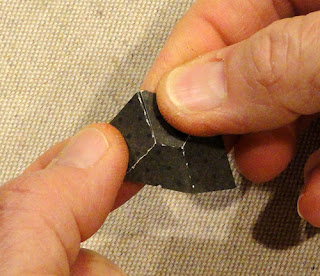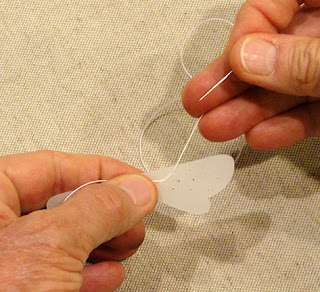Half-dome
stylized insect has face, stripes
and stinger body overlays, eyes, swirly
antennae,
pair of vellum wing overlays (optional hand-stitched
variation over
wing included).
Body side tabs mount to flat body base through slots.
accept a small gauge wire to
display in “flight”.
Or use as decoration element on box or package,
card
or dimensional post card.
Bee measures approx. 2.5” tall x 1.5” wide x .75” deep.
Coordinates
as element for BLOOM 3D Letter Box Ensemble.
ASSEMBLY: 1. Identify and cut the shapes:
A body dome B body base with slots
C body bottom to camouflage base openings
D head, eyes antennae unit with tab
E mid body accent, stripes (one not shown here),
tail end and stinger
F underwing with perforation bend line,
overwing (plain or opt. with stitching punch holes)
cut vellum
on all perforations for body panels, segments and
to overlap head top side straight edge over adjacent
straight side edge overlaps the adjacent narrow tab
overlap tab and align straight edge at perforation line,
and glue seam.
6. Repeat steps 3-5 for the other side of body.
7. Prepare the body accent, stripes (body top stripe
not shown here; see step 12), and tail/stinger overlay by
bending back of all perforation lines.
8. Prepare the head overlay shape by bending
back on all perforation lines for segments and
narrow wedge tabs at upper sides.
9. Complete each of the two upper side seams
by overlapping the inward straight edge across
the wedge tab to perforation and gluing in place.
10. Apply glue to the underside of the head overlay
then position over head end area of body dome
align perforations and edges, and glue in place.
11. Position and attach the top body accent, aligning
punch hole, front edges with body perforation lines,
and contour perforations.
12. Position and attach the top body stripe on
the adjacent dome panels at panels edges.
13. Position and attach the tail overlay where it
fits the body contours and edges, then . . .
. . . position and attach the mid stripe halfway
between the upper body stripe and tail overlay.
14. Prepare the underwing by partially bending along
the medium length perforation lines. This will give
the wings assembly some shape and "lift".
(Follow these next steps ONLY if adding stitching
detail to the optional punch holes wing shape.)
15. A) Study the following stitching detail illustration
that indicates where the stitching thread will connect
punch holes. NOTE that the semi-transparent vellum
that is recommended will allow thread passes on
the underneath side to be slightly visible from face side.
B) Refer to the following stitching hole numbered diagram
as the following stitching steps are described.
C) Thread a 20" length of button thread (thicker) on
a sewing needle that will fit through the stitching holes.
D) Hold a short tail on top of the wing at the center
brad hole, then insert the needle DOWN through base hole #1,
at bottom of array, and pull thread through.
E) Stitch UP through hole #3, then DOWN
through hole #2 to complete the first "stitch" line.
Pull up thread completely between each stitch
insertion, then finger press thread to encourage it
to stay straight, flat, and avoid loopy-ness that shows
through wing.
F) Stitch UP through hole #4, then DOWN through
hole #2.
G) Stitch up through hole #5, then . . .
. . . DOWN thru hole #6; UP thru hole #5,
then DOWN thru hole #7; UP thru hole #5;
DOWN thru hole #8.
H) UP thru hole #9, then . . .
. . . DOWN thru #8; UP thru #10; DOWN thru #8
I) UP thru #11.
J) Complete the center stitching by stitching DOWN
thru #8, UP thru #5, DOWN thru #2.
K) Complete the first wing stitching run by returning
needle and thread UP thru center punch hole.
L) Repeat steps D-K to complete stitching on second
wing. With thread tails at center, apply a dab of glue
to secure them neatly near center hole. Wait until
glue dries, then . . .
. . . trim excess even with top edge of wing.
(NOTE: tails should be further secured and hidden
by wing-to-body brad insertion.)
glue in place.
17. Position and attach eyes forward on
side head panels.
18. Layer over wing atop under wing, center
with brad punch holes aligned, adjust for balance,
then secure in place with a dab of glue near punch hole.
19. Position wing assembly over body assembly
so that holes align, then insert a black nail head brad
through all layers, and bend prongs back on inside
of body dome.
work tabs into the slots all around. (This may require
some patience and time.)
On the underside, bend tabs inward toward center . . .
. . . and glue in place.
21. To prepare and attach a "flying" wire, cut a medium
heavy gauge wire length (approx. 15") and use pliers
to form a small loop at top end.
22. Insert the non-loop end through FRONT of
bee, across body cavity, and . . .
. . . through BACK opening
at tail tip.
23. Prepare the end, if desired, by coiling the straight
part of the wire, beginning approx. 1.5" beyond exit point,
using a tool such as a dowel or the handle of this
spatula tool, to create several spiral wraps.
24. Apply glue to the body form rim, then position
and attach the opening camouflage base shape.
Press the edges all around until securely attached.
NOTE: one strategy is to use clips such as this group
of folio clips to apply pressure all around
as the glue dries completely.
Here is the completed bee figure.
25. If the Bee is being used as part of the BLOOM
ensembled, the long length of wire can be inserted
through TOP of B letter box and held in place
with interior strut, where it can be hot melt glued
in desired position. Or . . .
where it can be secured in place with a generous
bead of hot melt glue, with the optional rectangular
panel covering the wire end and glue, and further
securing in place.
This view shows the possible shaping of the bee's














































No comments:
Post a Comment